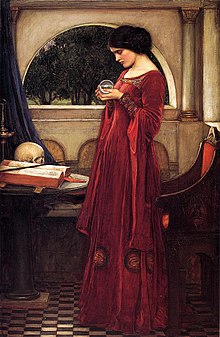
Back Kristalomantija BS Kristallomantie German Kristalomancija Croatian Cristalloscopia Italian スクライング Japanese Kristalkijken Dutch Perscrutar Portuguese Kristalomancija Serbo-Croatian Scrying Turkish
This article includes a list of general references, but it lacks sufficient corresponding inline citations. (January 2024) |

| Part of a series on the |
| Paranormal |
|---|
Scrying, also referred to as "seeing" or "peeping," is a practice rooted in divination and fortune-telling. It involves gazing into a medium, hoping to receive significant messages or visions that could offer personal guidance, prophecy, revelation, or inspiration.[1] The practice lacks a definitive distinction from other forms of clairvoyance or divination but generally relies on visions within the chosen medium. Unlike augury, which interprets observable events, or divination, which follows standardized rituals, scrying's impressions arise within the medium itself.
The terminology and methods of scrying are diverse and lack a standardized structure. Practitioners coin terms such as "crystallomancy," "spheromancy," or "catoptromancy," naming practices based on the medium or technique employed. These practices have been reinvented throughout history, spanning cultures and regions. Scrying media encompass reflective, refractive, or luminescent surfaces like crystals, mirrors, water, fire, or smoke. Some practitioners even close their eyes, engaging in "eyelid scrying."
Methods of scrying often induce self-induced trances, using media like crystal balls or even modern technology like smartphones. Practitioners enter a focused state that reduces mental clutter, enabling the emergence of visual images. These initial images, however trivial, are amplified during the trance. Some scryers report that they hear their voice affirming what they see, creating a mental feedback loop.
Throughout history, various traditions and cultures have practiced scrying as a means of revealing the past, present, or future. The practice involves diverse media, from reflective surfaces to shimmering mirages, and is often accompanied by rituals inducing altered states of consciousness. Despite its popularity in occult circles and its portrayal in media, scrying lacks empirical support and is met with skepticism from the scientific community.
- ^ Brown, Lesley (1993). The New shorter Oxford English dictionary on historical principles. Oxford [Eng.]: Clarendon. ISBN 978-0-19-861271-1.